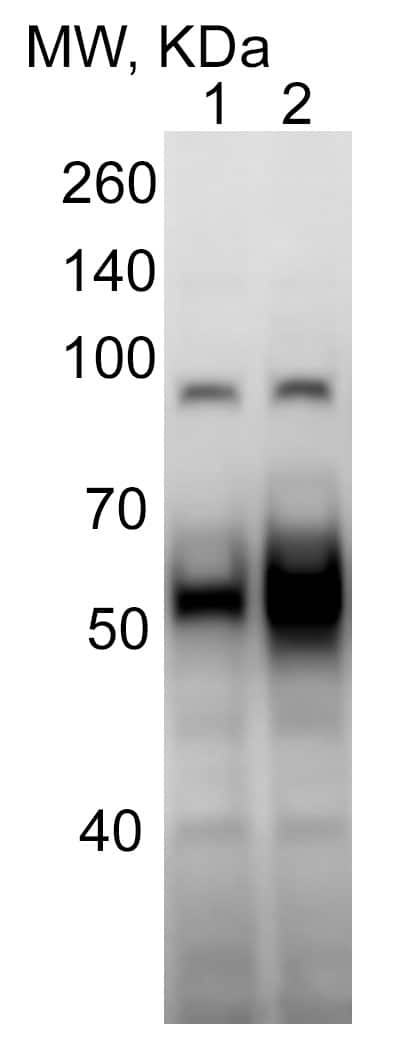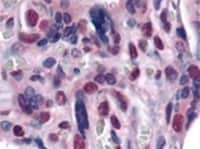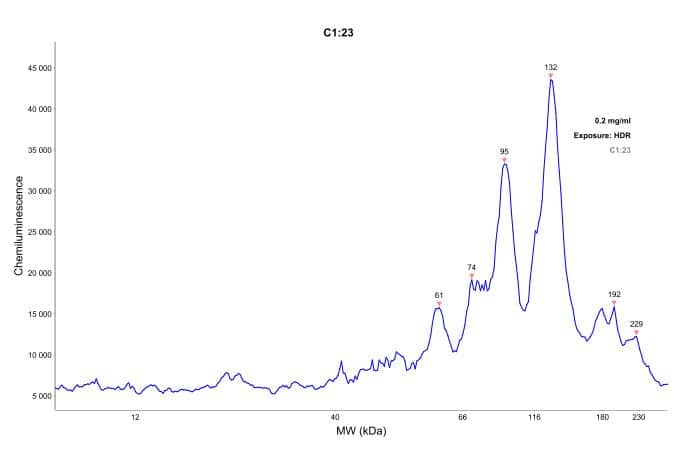| Description | (1) The ATF6 (IMG-273) has been cited to recognize both full-length and cleaved forms of ATF6. Please refer to the references in the Product Citation list for more comprehensive information.
(2) The ATF6 transfected cell lysate (40210) is recommended as a useful western blot positive control to run in parallel with your experimental samples. (3) Active/cleaved forms of ATF6 are generated through proteolytic cleavage during ER stress. Different molecular weights have been described for cleaved forms. A sample protocol was first described in Luo and Lee (2002) wherein NIH3T3 cells were treated with the amino acid analogue azetidine (AzC), and full-length and cleaved forms ATF6 were detected with IMG-273. The results show that in addition to the major 90 kDa full length ATF6, protein bands over the range of 50-70 kDa were detectable following AzC treatment (Luo and Lee, 2002: Figure 4A, page 791). Many protocols and other cleaved forms have been described since, please consult the literature for additional information. (4) For immunofluorescence microscopy, cells were fixed in methanol at -20 degrees C (Thomas et al, 2005). Thomas et al used immunofluorescence to identify ATF6 with IMG-273 in the nucleus. (5) The active/cleaved 50 kDa nuclear form of ATF6 using IMG-273 has been found to be strongly expressed in certain tumor cell lines derived from B cell lymphoma (DEL), primary effusion lymphoma [BC-3 (ATCC CRL-2277), PEL-SY, HBL-6], lymphoblastic leukemia (DS-1) and multiple myeloma (RPMI-8226, NCI-H929), (Jenner et al. 2003). (6) Cleaved 60 and 36 kDa ATF6 forms have also been described in the nucleus (Mao et al, 2007). (7) The ATF6 antibody is reported to be specific for ATF6a, recognizing ATF6a but not ATF6b (Bommiasamy et al, 2009). (8) In western blots, the binding pattern of ATF6 may vary. Researchers are encouraged to consult the body of literature citing the ATF6 IMG-273 antibody (see Product citation list) for additional information. General ATF6 literature is also helpful. For example, Yoshida (1998) show a multiple band pattern in HeLa in both untreated and stressed cells (Fig 11B). In this early landmark ATF6 publication, multiple bands were seen between the 66 and 116 kDa markers as well as one or more bands between the 45 and 66 kDa markers. (9) We highly recommend the use of a maximum sensitivity ECL substrate (Femto sensitive) for efficient detection of this antibody in Western blot applications. |
| Immunogen | This monoclonal antibody was made against a partial protein containing amino acids 1-273 of human ATF6. |
| Specificity | This ATF6 antibody detects both the full length and the cleaved/active protein. |
| Isotype | IgG1 Kappa |
| Clonality | Monoclonal |
| Host | Mouse |
| Gene | ATF6 |
| Purity | Protein G purified |
| Innovator's Reward | Test in a species/application not listed above to receive a full credit towards a future purchase. |
| Dilutions |
|
||
| Application Notes | ICC: See Thomas et al (2005) and Kikuchi et al (2006) for details. Immunohistochemistry (Frozen): See Zhu et al (2008) for details. Immunohistochemistry (Paraffin): See van Kollenburg et al (2006) for details. Immunoprecipitation: See Hong et al, 2004 for details. Use in Immunoblotting reported in scientific literature (PMID 28550308). Knockout validation (PMID: 31531232). In Western blot do not use milk in the diluent as it can inhibit the observed signal. This antibody is CyTOF ready. |
||
| Control |
|
||
| Reviewed Applications |
|
||
| Publications |
|
| Storage | Store at 4C short term. Aliquot and store at -20C long term. Avoid freeze-thaw cycles. |
| Buffer | PBS |
| Preservative | 0.02% Sodium Azide |
| Concentration | 1.0 mg/ml |
| Purity | Protein G purified |
| Images | Ratings | Applications | Species | Date | Details | ||||||||||
|---|---|---|---|---|---|---|---|---|---|---|---|---|---|---|---|

Enlarge |
reviewed by:
Armen Petrosyan |
WB | Mouse | 11/19/2024 |
Summary
|
||||||||||

Enlarge |
reviewed by:
Armen Petrosyan |
IF | Mouse | 11/19/2024 |
Summary
|
||||||||||

Enlarge |
reviewed by:
Armen Petrosyan |
WB | Human | 06/27/2023 |
Summary
|
||||||||||

Enlarge |
reviewed by:
Verified Customer |
WB | Human | 06/27/2023 |
Summary
|
||||||||||

Enlarge |
reviewed by:
Verified Customer |
IHC-P | Human | 01/24/2022 |
Summary
Comments
|
||||||||||

Enlarge |
reviewed by:
yann Jaudouin |
WES protein simple | Rat | 09/14/2018 |
Summary
Comments
|
||||||||||

Enlarge |
reviewed by:
Shinobu Miyazaki |
WB | Mouse | 03/18/2016 |
Summary
|
Secondary Antibodies |
Isotype Controls |
Research Areas for ATF6 Antibody (NBP1-40256)Find related products by research area.
|
|
ATF6 - monitoring and regulating protein folding under cellular stress During times of cellular stress overloading of the protein folding machinery leads to the accumulation of incorrectly folded proteins. This triggers the unfolded protein response (UPR) in order to try to reestablish homeostasis or, if this fails, t... Read full blog post. |
|
ATF6 - a key target in alcohol-induced fatty liver disease? The ATF6 endoplasmic reticulum (ER) stress-regulated transcription factor is constitutively expressed and plays a central role in the mammalian unfolded protein response (UPR). This fundamental pathway is responsible for balancing cellular hom... Read full blog post. |
|
A Key to Fight Stress: ATF6 The protein ATF6 is a constitutively expressed transcription factor that is a key mediator of the unfolded protein response (UPR) that allows mammalian cells to maintain cellular homeostasis under conditions of environmental and physiological stress. ... Read full blog post. |
The concentration calculator allows you to quickly calculate the volume, mass or concentration of your vial. Simply enter your mass, volume, or concentration values for your reagent and the calculator will determine the rest.
5 | |
4 | |
3 | |
2 | |
1 |
| Armen Petrosyan 11/19/2024 |
||
| Application: | WB | |
| Species: | Mouse |
| Armen Petrosyan 11/19/2024 |
||
| Application: | IF | |
| Species: | Mouse |
| Armen Petrosyan 06/27/2023 |
||
| Application: | WB | |
| Species: | Human |